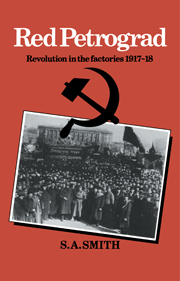Book contents
- Frontmatter
- Contents
- Acknowledgements
- Introduction
- 1 A profile of the Petrograd working class on the eve of 1917
- 2 The tsarist factory
- 3 The February Revolution: A new dispensation in the factories
- 4 The structure and functions of the factory committees
- 5 Trade unions and the betterment of wages
- 6 The theory and practice of workers' control of production
- 7 Deepening economic chaos and the intensification of workers' control
- 8 The social structure of the labour movement
- 9 The October Revolution and the organisation of industry
- 10 The economic crisis and the fate of workers' control: October 1917 to June 1918
- Conclusion
- Notes
- Bibliography
- Index
8 - The social structure of the labour movement
Published online by Cambridge University Press: 11 January 2010
- Frontmatter
- Contents
- Acknowledgements
- Introduction
- 1 A profile of the Petrograd working class on the eve of 1917
- 2 The tsarist factory
- 3 The February Revolution: A new dispensation in the factories
- 4 The structure and functions of the factory committees
- 5 Trade unions and the betterment of wages
- 6 The theory and practice of workers' control of production
- 7 Deepening economic chaos and the intensification of workers' control
- 8 The social structure of the labour movement
- 9 The October Revolution and the organisation of industry
- 10 The economic crisis and the fate of workers' control: October 1917 to June 1918
- Conclusion
- Notes
- Bibliography
- Index
Summary
THE SOCIAL COMPOSITION OF LABOUR PROTEST AND LABOUR ORGANISATION
In Chapter 1 it was argued that two broad groups can be discerned within the Petrograd working class in 1917: the proletarianised, skilled, mainly male workers, and the new, younger peasant and women workers. It was the former group of ‘cadre’ workers who built the factory committees and trade unions after the February Revolution. Quantitative data to bear out this contention are lacking, although a survey of fitters at the Putilov works in 1918, conducted by Strumilin, showed that skilled workers dominated all labour organisations and had been the first to join the metal union in 1917. This is borne out by a complaint in the industrialists' newspaper in the spring of 1917 that ‘it is usually the most skilled workers, they being the most conscious, who participate in the different committees – the factory committees, Soviets etc.’. The same sentiment was voiced by A. Gastev at the first national congress of metalworkers: ‘in the unions we operate by basing ourselves on the skilled element of the workforce, for example, the turners and fitters … this is the most active section of the working class. The unskilled workers are, of course, less active.’ Skilled, experienced workers had a greater capacity than new workers to initiate a social movement and to carry out consciously-willed social change.
- Type
- Chapter
- Information
- Red PetrogradRevolution in the Factories, 1917–1918, pp. 190 - 208Publisher: Cambridge University PressPrint publication year: 1983



